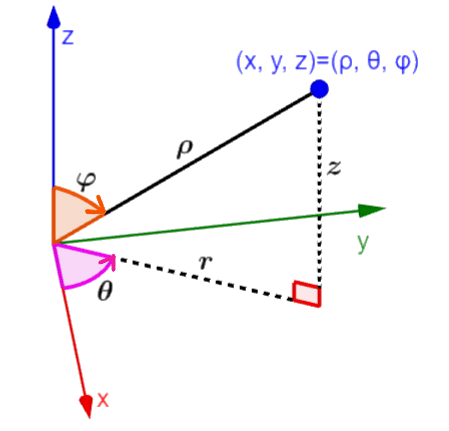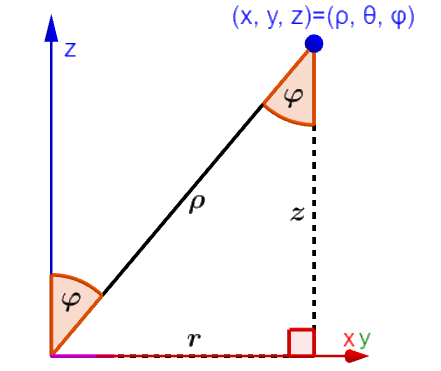Spherical coordinates have the form (ρ, θ, φ), where, ρ is the distance from the origin to the point, θ is the angle in the xy plane with respect to the x-axis and φ is the angle with respect to the z-axis. These coordinates can be transformed to Cartesian coordinates using right triangles and trigonometry. We use the sine and cosine functions to find the vertical and horizontal components and obtain expressions for x, y, z in terms of ρ, θ, φ.
Here, we will derive the formulas that we can use to transform from spherical to Cartesian coordinates. Then, we will apply these formulas by solving some practice problems.
TRIGONOMETRY

Relevant for…
Learning to transform from spherical to Cartesian coordinates.
TRIGONOMETRY

Relevant for…
Learning to transform from spherical to Cartesian coordinates.
How to transform from spherical coordinates to Cartesian coordinates?
Spherical coordinates have the form (ρ, θ, φ). In this form, ρ represents the distance from the origin to the point, θ represents the angle in the xy plane with respect to the x-axis and φ represents the angle with respect to the z-axis.
On the other hand, three-dimensional Cartesian coordinates have the form (x, y, z).

To transform from spherical to Cartesian coordinates, we have to use right triangles and trigonometry. To facilitate the derivation of the transformation formulas, we can start by transforming from spherical to cylindrical coordinates, and then, we can transform from cylindrical to Cartesian coordinates.
Therefore, we use the following diagram:

We know that the angle between the z-axis and ρ is equal to φ. Using a bit of geometry, we also know that φ is the angle between ρ and the vertical side of the triangle. Then, using trigonometry, we have:
$latex z=\rho \cos(\phi)$
$latex r=\rho \sin(\phi)$
We also have $latex \theta= \theta$. These are the formulas that allow us to convert from spherical to cylindrical coordinates. Now, we can use the cylindrical to Cartesian coordinate transformation formulas:
$latex x=r~\cos(\theta)$
$latex y=r~\sin(\theta)$
$latex z=z~~~~~$
Using these two sets of equations, we can obtain the transformation formulas from spherical to Cartesian coordinates:
| $latex x=\rho \sin(\phi)\cos(\theta)$ $latex y=\rho \sin(\phi)\sin(\theta)$ $latex z=\rho \cos(\phi)~~$ |
Spherical to Cartesian coordinates – Examples with answers
The following exercises are solved using the formulas for converting spherical to Cartesian coordinates. Each example has its respective solution, but it is recommended that you try to solve the problems yourself before looking at the answer.
EXAMPLE 1
We have the point $latex (10, \frac{\pi}{4}, \frac{\pi}{4})$ in spherical coordinates. What is its equivalence in Cartesian coordinates?
Solution
We have the values $latex \rho=10,~\theta=\frac{\pi}{4},~\phi=\frac{\pi}{4}$. Now, we use these values in conjunction with the formulas seen above to find the values of x and y. Therefore, the value of x is:
$latex x=\rho~\sin(\phi)\cos(\theta)$
$latex x=10~\sin(\frac{\pi}{4})\cos(\frac{\pi}{4})$
$latex x=14.14$
The value of y is:
$latex y=\rho~\sin(\phi)\sin(\theta)$
$latex y=10~\sin(\frac{\pi}{4})\sin(\frac{\pi}{4})$
$latex y=14.14$
The value of z is:
$latex z=\rho~\cos(\phi)$
$latex z=10~\cos(\frac{\pi}{4})$
$latex z=7.07$
The Cartesian coordinates of the point are (14.14, 14.14, 7.07).
EXAMPLE 2
The point $latex (5, \frac{3 \pi}{2}, \frac{\pi}{3})$ is in spherical coordinates. What is its equivalence in Cartesian coordinates?
Solution
We have the values $latex \rho=5,~\theta=\frac{3\pi}{2},~\phi=\frac{\pi}{3}$. We find the values of x, y and z using the formulas seen above. We start with the value of x:
$latex x=\rho~\sin(\phi)\cos(\theta)$
$latex x=5~\sin(\frac{\pi}{3})\cos(\frac{3\pi}{2})$
$latex x=0$
The value of y is:
$latex y=\rho~\sin(\phi)\sin(\theta)$
$latex y=5~\sin(\frac{\pi}{3})\sin(\frac{3\pi}{2})$
$latex y=-4.33$
The value of z is:
$latex z=\rho~\cos(\phi)$
$latex z=10~\cos(\frac{\pi}{3})$
$latex z=5$
The Cartesian coordinates of the point are (0, -4.33, 5).
EXAMPLE 3
If we have the spherical coordinates $latex (8, \frac{2 \pi}{5}, \frac{\pi}{5})$, what is their Cartesian coordinate equivalence?
Solution
We have the values $latex \rho=8,~\theta=\frac{2\pi}{5},~\phi=\frac{\pi}{5}$. We find the values of x, y, z using the transformation formulas. Therefore, the value of x is:
$latex x=\rho~\sin(\phi)\cos(\theta)$
$latex x=8~\sin(\frac{\pi}{5})\cos(\frac{2\pi}{5})$
$latex x=1.45$
The y component is:
$latex y=\rho~\sin(\phi)\sin(\theta)$
$latex y=8~\sin(\frac{\pi}{5})\sin(\frac{2\pi}{5})$
$latex y=4.47$
The z component is:
$latex z=\rho~\cos(\phi)$
$latex z=8~\cos(\frac{\pi}{5})$
$latex z=6.47$
The Cartesian coordinates of the point are (1.45, 4.47, 6.47).
EXAMPLE 4
We have the point $latex (10, \frac{\pi}{4}, \frac{4 \pi}{3})$ in spherical coordinates. What is its equivalence in Cartesian coordinates?
Solution
We have the values $latex \rho=10,~\theta=\frac{\pi}{4},~\phi=\frac{4\pi}{3}$. Using these values along with the conversion formulas, we are going to find the components x, y and z. Therefore, the x component is:
$latex x=\rho~\sin(\phi)\cos(\theta)$
$latex x=10~\sin(\frac{4\pi}{3})\cos(\frac{\pi}{4})$
$latex x=-6.12$
The y component is:
$latex y=\rho~\sin(\phi)\sin(\theta)$
$latex y=10~\sin(\frac{4\pi}{3})\sin(\frac{\pi}{4})$
$latex y=-6.12$
The z component is:
$latex z=\rho~\cos(\phi)$
$latex z=10~\cos(\frac{4\pi}{3})$
$latex z=-5$
The Cartesian coordinates of the point are (-6.12, -6.12, -5).
Spherical to Cartesian coordinates – Practice problems
Use the transformation formulas seen above to solve the following exercises and convert the spherical coordinates to Cartesian coordinates. If you need help with this, you can look at the solved examples above.
See also
Interested in learning more about spherical coordinates? Take a look at these pages:



